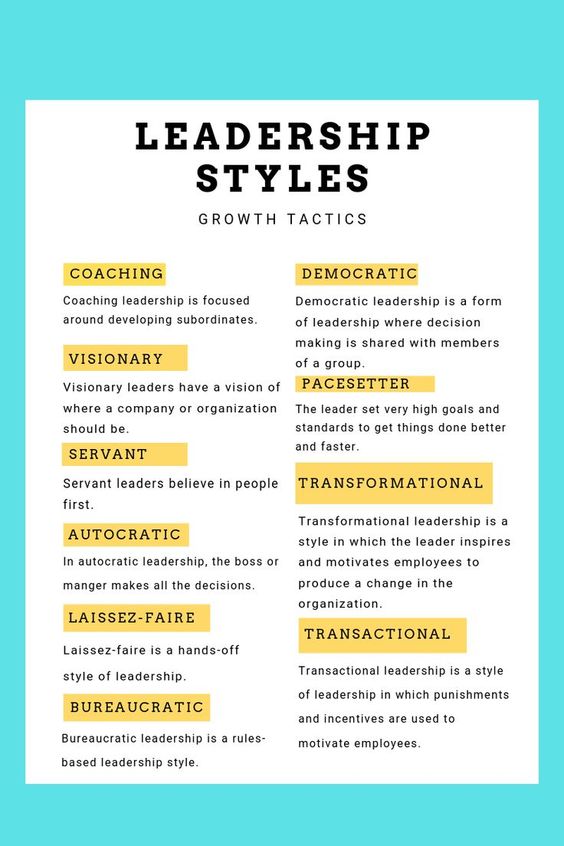Recognizing various types of supervisory styles and knowing the right time to use them will increase your abilities as a supervisor, a father, a mother, and many other areas of your life. Knowing these 10 types of leadership styles will help you identify areas you need to improve in your leadership.
It can also be a huge benefit to recognize these styles of leadership in others. It can help you better deal with a supervisor.
Additionally, it can help you better deal with a leader underneath you. If you understand what their specific leadership style is, you can help them increase that ability and make them aware of other supervisor styles that may be more useful in certain situations.

Jump To Section
10 Different Styles of Leadership
1. Coaching Leadership Style

Coaching leadership is a common leadership style focused on developing subordinates. Another focus of coaching leadership is getting teams to perform well together. This type of leadership is used to motivate employees. Furthermore, it helps build a collective vision.
In the coaching style of leadership, leaders are open to feedback and ideas from subordinates. Leaders understand that great ideas can come from anyone on the team.
Coaching leaders don’t micro-manage. Instead, they motivate members of their team to achieve both personal and professional goals.
Disadvantages
In this type of leadership, there are some disadvantages. Results and tasks can sometimes take some time because of the coaching leader’s need to teach. This may not be the best type of leadership style when results are needed immediately.
Also, when there are long-term lessons to be learned the coaching leader accepts short-term failure. This may not be optimal in no-fail situations.
Advantages
Although there are some disadvantages, coaching leadership may be very useful over other types of leadership styles at times. Knowing when to use coaching leadership can be very helpful for a leader.
There are many situations where you should use this style over other leadership styles in management. When using this style, you will likely see a decrease in short-term results but long-term results will be significantly increased. This makes the organization stronger and stronger over time.
Coaching Leadership Example
There have been a lot of great leaders that have chosen coaching leadership over other types of leadership styles to put their mark on history. For instance, Facebook’s Mark Zuckerberg and Apple’s Steve Jobs inspired and motivated their employees to innovate new products and services.
See Related: Brian Tracy Leadership Questionnaire
2. Visionary Leadership Style

Visionary leaders have a vision of where a company or organization should be. They tend to see the big picture and normally don’t worry as much about the small details.
These leaders shift people and processes in a way to get them closer to their vision of what the company should be.
Visionary leaders are charismatic and determined to strive for their goals. They are this way because they really believe in the change they are making.
This type of leadership is great before and during transition phases within a company. These leaders are great at rallying the troops and keeping them moving forward.
Disadvantages
There are times when other styles of management are more useful. For example, this type of leadership can be very difficult when employees are stuck in their ways.
Another downside to this type of leadership is the leader may become too pivotal. When the leader becomes the face and the only driving force the area can revert in the leader’s absence. To avoid this, leaders must instill their vision in others, so they can lead the charge in the leader’s absence.
Advantages
In the ever-changing world, we live in, this type of leadership can be very valuable for companies or organizations looking to improve. Adaptability is very important.
These leaders encourage employees to push forward and get better. Knowing when to use visionary leadership can be very helpful for a leader.
Visionary Leadership Example
Many great leaders have used visionary leadership over other types of management styles, making an impact on the world. For example, Martin Luther King was an extraordinary visionary leader that was able to get millions and still motivates people toward the great cause of equal rights. Even over 50 years after his death.
See Related: How to Be More Charismatic (21 Surefire Ways)
3. Servant Leadership Style

The key concept behind servant leadership is to take care of your people and they will take care of the job. In this leadership approach, leaders believe in people first. Although they may be the boss, they work for their employees.
Servant leaders will put the problems and goals of their subordinates over their own. Employees typically like servant leaders because of their ability to fulfill the employee’s needs and empower them.
A good servant leader understands the difference between needs and wants. Contrary to popular belief, taking care of somebody’s needs is not the same thing as giving them everything they want. Giving people everything they want can be very counterproductive to the goals of the organization.
Disadvantages
In a culture where hierarchy is very important, servant leaders may struggle because all the decisions are expected to be made by the leader.
In this type of environment, a servant leader may be looked at as weak and ultimately may have a hard time gaining the respect of others. More so than most other types of leadership styles.
Advantages
Knowing when to use servant leadership can be very helpful for a leader.
This type of leadership can be very useful to keep employees focused on the job. The servant-leader takes care of others’ needs removing roadblocks to production.
Servant Leadership Example
Many religious leaders are good examples of servant leadership. Their job is to serve others. They build their following and power because of their willingness to serve others.
4. Autocratic Leadership Style

In autocratic leadership, the boss or manager makes all the decisions. Employees follow the boss’s directions without any hesitation or deviation. Ultimately, the autocratic leader has absolute control over the group, unlike most other leadership styles.
Autocratic leaders rarely accept advice from others. They base their decisions on their own views and judgment of situations.
Furthermore, autocratic leaders tend to have clearly outlined and communicated rules. Many times, employees are micromanaged, because the boss doesn’t trust subordinates with decisions.
Disadvantages
With this type of leadership, creativity, and innovation can be very limited because the input is not accepted by others by the boss. Employees may not feel valued, in this environment, diminishing morale. In the long run, this can lead to employee resentment of the boss.
Advantages
Although this type of leadership sounds very negative it can be useful if used in the right situations.
Knowing the right time to use this autocratic leadership is very important. When decisions must be made quickly, the autocratic leadership style is very effective.
Another good use of this style is when employees are very inexperienced and require very clear and direct instructions. Use this leadership style on a very limited basis, so morale and creativity are not destroyed.
Autocratic Leadership Example
Donald Trump is an example of a leader that has utilized the autocratic leadership style. In many of his business ventures, all decisions went through him. His subordinates make very few calls of their own.
5. Laissez-faire Leadership Style

Laissez-faire is a hands-off style of leadership. Members of the team are free to make most job-related decisions.
The expectation from a laissez-faire leader is for the team to solve problems with minimal input from the boss. Supervisors will step in during crises or major decisions but for the most part, are hands-off.
The key to this type of leadership is trust. A leader must have a high level of trust in their subordinates since they have the freedom to make so many decisions.
Laissez-faire leadership is built on the idea that if you build a strong team, they will take care of the job. On the other hand, this leadership style doesn’t work if you don’t have the right people on the team. Employees that are self-starters and require little direction fit in well with this leadership style.
Disadvantages
There are situations where this style is not as effective as other types of leadership styles.
With the wrong type of employees or in the wrong situation this leadership style doesn’t work. Employees that aren’t self-starters will be very unproductive in this environment.
Additionally, inexperienced employees will have a hard time learning how to do their job effectively with the lack of direction and feedback.
Furthermore, superiors can look at this type of leadership as laziness in certain industries and situations. In these scenarios, other styles of leadership are better to use.
Advantages
Although this type of leadership is not ideal for all situations, knowing when to use laissez-faire leadership has many advantages when used correctly.
For starters, giving subordinates freedom fosters creativity. Leaders can focus their time and efforts on other areas when employees don’t need much guidance and direction. This type of leadership can give the right team members a better sense of satisfaction because they take greater ownership of the job.
Laissez-Faire Leadership Example
Although Warren Buffet used many types of leadership styles, he is known for using Laissez-Faire leadership at times. He is known for allowing his high-level associates to run the companies he owns.
Buffet uses a hands-off approach allowing his managers to take the ball and run with it after making many of his investment decisions. He trusts that his managers know how to achieve the results he wants. Warren Buffet was quoted saying “Pick out associates whose behavior is better than yours and you’ll drift in that direction.”
6. Democratic Leadership Style

Democratic leadership is a form of leadership where decision-making is shared with members of a group unlike most other types of leadership. Participative or shared leadership are other common names for this leadership style.
Even though there may be a clear-cut manager or supervisor, in this type of leadership it’s important that everybody’s ideas are equal, and discussions are encouraged. All members are given the opportunity to participate and get their voices heard.
The job of a democratic leader is to facilitate discussions. They ensure discussions stay on topic and don’t get out of hand.
The leader also ensures all opinions are voiced before a decision is made. Furthermore, the leader chooses who is part of the decision-making process. The leader maintains the final say in the decision-making process.
Disadvantages
Just like any form of leadership, there are some disadvantages to the democratic style. At times the decision-making process can take a lot longer than other forms of leadership.
Members can begin to feel like their not being heard when their decisions or ideas are not followed by the leader. If not headed off by the leader, this type of leadership can lead to in-fighting when members disagree with each other. If group members are very knowledgeable or experienced, group decisions or discussions may not be very productive for a leader in this style of leadership.
Advantages
Although there are disadvantages, knowing when to use the democratic leadership style is very strong in many situations and should be a frequently used tool in any leader’s arsenal.
This leadership can help give employees a sense of ownership with decisions. Typically, when employees feel at least partially responsible for decisions, they will work harder to make them a success.
Creativity is also increased in this type of leadership because everybody is encouraged to share ideas.
Democratic Leadership Example
Although John F. Kennedy used many different management styles throughout his presidency, he is a great example of a leader that used the democratic leadership style. He surrounded himself with many knowledgeable and experienced advisors and cabinet members. He relied heavily on these people at times to help him reach the best decisions.
7. Pacesetter Leadership Style

In pace-setting leadership, the focus is on high productivity. Very high goals and standards to get things done better and faster are set by the leader.
The leader is a very high performer and also expects the same from those working for him or her.
Employees that are not performing well in this leadership are quickly identified. If the leader can’t bring them up to pace, they are typically replaced. Even if an employee is doing their best it may not meet the leader’s standards.
In this leadership style, the leader is quick to jump in and help the team achieve the highest results. These leaders believe in leading by example.
Many times, these leaders were very good workers that got promoted because of their hard work ethics. These leaders try to mold or force their subordinates to be like them.
Disadvantages
The pacesetter leader can be devastating to morale, more than many other types of leadership styles. People can get demoralized when the leader jumps in because he/she thinks they are lagging.
Also, the employees may feel like the leader doesn’t trust them to do their job. Furthermore, mentorship and feedback are not a priority in this type of leadership. In summary, this can lead to a lack of internal growth over the long run.
Advantages
Although this style of leadership should be used very sparingly, knowing when to use pacesetting leadership can be useful.
This can be a productive style in certain situations with experienced employees that are self-starters. This would also work with competitive employees to increase production but if used too often may lead to burnout in employees.
Pacesetter Leadership Example
Many great leaders have used this style at times during their reign. Jack Welch, for example, was known for his lead-by-example style of leading. He also let nearly 100,000 employees go between the years of 1981 and 1985 while CEO at General Electric.
8. Transformational Leadership Style

Transformational leadership is a style in which the leader inspires and motivates employees to produce a change in the organization.
This change is created through creativity. The leader fosters creativity by allowing employees the freedom to be creative and ultimately grow the company.
A transformational leader is not a micromanager. Furthermore, the transformational leader fosters growth in employees through mentorship and training. This constant development of others strengthens the team and also the organization.
The transformational leader exemplifies moral standards, ethical work practices, and authenticity. Furthermore, they tend to be very charismatic leaders. They also encourage these qualities in their followers. This produces a mindset in team members of working towards a common good.
By instilling their values and vision in others, in the long run, subordinates require less supervision.
Disadvantages
Although transformational leadership is one of the best and most versatile leadership styles, it can have some drawbacks. The transformational leader is very charismatic and very good at building followership. If the leader is unknowingly on the wrong path, others may follow that leader in the wrong direction.
Also, at times the leader may not see the problems right in front of them because they are so focused on their vision.
Advantages
There are many advantages to this leadership style. Knowing when to use transformational leadership is essential for a leader.
Transformational leadership can be very useful in organizations going through a change or requiring a change. Also, employee morale and satisfaction are typically high under these types of leaders. This can cause many positives like higher production and higher retention. Furthermore, increased creativity by employees can lead to company growth.
Transformational Leadership Example
Many great leaders chose this style over other types of leadership styles to produce change and take their teams to the next level. Reed Hastings, the CEO of Netflix, saw enormous growth in his company using transformational leadership. He inspired and motivated his employees fostering creativity, taking the company from a by-mail DVD rental business model to a streaming mogul.
9. Transactional Leadership Style

Transactional leadership is a style of leadership in which punishments and incentives are used to motivate employees. When employees achieve certain results, rewards are given. When results are not achieved, punishments are administered.
This leadership style focuses on three basic concepts, organizing, controlling, and short-term planning. The leader must keep the team organized and on the same page.
The leader must control the team, meaning he/she sets guidelines and measures to achieve results. It’s also the role of the leader to set short-term plans and goals for his team.
The best transactional leaders understand what motivates their subordinates. Understanding the motivation of others can be used to get better results from employees.
Common motivations are extra time off, higher pay, public recognition, and not getting fired, just to name a few.
Disadvantages
Although this type of leadership can be useful in many situations, it also has its drawbacks.
At times the leader may not always account for employees’ values and emotions. If the leader misjudges what motivates others, they may not see the results they are looking for.
In some situations, the leader is so focused on results that team strength and chemistry suffer.
Advantages
Even with the disadvantages, knowing when to use transactional leadership is very useful for many reasons.
Since the leader has a structured plan on how to deal with positive and negative results, this is a very easy-to-manage leadership style. This method can very productive when there is a time crunch.
Transactional Leadership Example
Many companies and organizations use transactional leadership to get more out of their employees. For example, many players in the National Football League have performance incentives built into their contracts. On the other side, if players are not performing well, coaches may make them run laps or do other exercises to try to bring their performance up.
10. Bureaucratic Leadership Style

Bureaucratic leadership is one of the oldest styles of leadership. It is a rules-based style. There is very little flexibility in this system. Rules are expected to be followed with no deviation.
Typically, in this type of leadership, the leader’s power comes from the position they are in. Even leaders within this style are bound by rules and regulations.
Bureaucratic leadership has a very strict command structure. The command structure is comprised of a formal hierarchy. This hierarchy is apparent to all involved. Very specific roles are assigned to leaders and subordinates based on their skill sets.
Leaders within this style must have a certain set of qualities in order to succeed. They should be detail-oriented, ensuring even the minuscule rules and regulations are followed. Bureaucratic leaders must be hard workers.
Since this is a micromanagement leadership style and not a hands-off approach, these leaders are constantly busy monitoring and controlling subordinates. These leaders should be task-focused, getting tasks accomplished efficiently and quickly.
Disadvantages
This type of leadership style has its disadvantages.
Because of the strict rules and regulations, there is not a lot of room for out-of-the-box thinking. This stifles creativity. People within this structure are rewarded for following the rules. Therefore, there is not a lot of emphasis on advancing expertise in people’s specific areas. Changes in this system are very rough because of the reliance on rules and regulations.
Advantages
Although bureaucratic leadership has its disadvantages, there are also some advantages to this type of leadership.
Knowing when to use bureaucratic leadership is important. Professionalism is normally high because of the reliance on rules.
The introduction of new people into this type of leadership can be easier because roles and responsibilities are clearly defined. This system can be very useful over other types of leadership styles in places where very repeatable processes are accomplished.
Beauricratic Leadership Example
Colin Powell is an example of a leader that utilized the bureaucratic leadership style. Due to his military background, he knew the power and strengths of the bureaucratic style. He used systems to maximize efficiency. Powell’s focus was always on the task ahead of him. He believed everyone should know their job.
How to Find the Best Leadership Style to Use
As a leader, you know that your leadership style can have a significant impact on the success of your team. But with so many various leadership styles to choose from, how do you know which leadership style is most effective for you? Here are some tips to help you find the perfect fit and become a more effective leader:
- Assess your strengths and weaknesses: Start by taking an honest look at your own skills and personality traits. Are you naturally assertive or more laid-back? Do you excel at inspiring others or are you more analytical? Understanding your own strengths and weaknesses can help you identify which leadership style will work best for you.
- Consider your team’s needs: Your team’s needs should also play a role in determining your leadership style. Are they highly motivated and self-directed, or do they need more guidance and direction? Tailor your style to meet the unique needs of your team.
- Experiment with different styles: Don’t be afraid to try out different leadership styles to see what works best for you. You may find that a certain style feels more natural or effective than others.
- Get feedback: Finally, seek feedback from your team to see how your leadership style is working. Are they responding positively to your approach, or do they feel like something needs to change? Use their feedback to make adjustments and fine-tune your style over time.
Remember, there is no one-size-fits-all approach to leadership. The key is to find a style that aligns with your strengths, your team’s needs, and your overall goals. By taking the time to assess your options and experiment with different styles, you can find the most effective leadership style for you and your team.
What to Do with the 10 Different Types of Leadership
A great leader doesn’t just stick with one style, try to utilize the types of leadership styles that are best for the situation. We all have our strengths and may lean toward one type of leadership style but knowing when to use different types of leadership styles is the key to being the best leader you can be.
It’s important to understand the different situations and different people you deal with throughout your career. Different types of leadership styles are stronger in different situations and different people respond differently to each leadership style.
If you enjoyed this article on 10 common types of leadership styles, please share it with the buttons below.
FAQ
Q: What are the 10 most common leadership styles?
A: The 10 most common leadership styles include authoritative leadership, participative leadership, delegative leadership, pacesetting leadership, transformational leadership, transactional leadership, servant leadership, situational leadership, democratic leadership, and autocratic leadership. Each style has its own unique approach and effectiveness depending on the context and team dynamics.
Q: How can I identify my leadership style?
A: Discovering your leadership style involves reflecting on your leadership skills, understanding how you interact with team members, and considering feedback from team members. You can also explore the characteristics of the 10 different leadership styles to see which aligns best with your natural tendencies and values.
Q: What is participative leadership?
A: Participative leadership, also known as democratic leadership, is a style where leaders encourage team members to contribute to decision-making processes. This style values collaboration and input, making team members feel more involved and invested in the outcomes.
Q: What are the pros and cons of different leadership styles?
A: Each of the 10 leadership styles has its own pros and cons. For example, participative leadership fosters teamwork and innovation, while authoritative leadership provides clear direction and decisiveness. Understanding the leadership styles and their pros can help leaders choose the right approach for their specific situation.
Q: How does emotional intelligence relate to leadership styles?
A: Emotional intelligence plays a crucial role in effective leadership. Leaders with high emotional intelligence can adapt their leadership style to meet the needs of their team members and the situation at hand. This adaptability is key in employing different leadership styles effectively.
Q: What is the delegative leadership style?
A: Delegative leadership, also known as laissez-faire leadership, is a style where leaders provide minimal direction and allow team members to make decisions. This style works best when team members are highly skilled and motivated, as it empowers them to take ownership of their work.
Q: How can I improve my leadership skills?
A: Improving your leadership skills involves continuous learning and self-reflection. Engaging in training programs, seeking mentorship, and actively seeking feedback from team members can help you develop a clearer vision and better understand which leadership style may be most effective for your team.
Q: What is the situational leadership style?
A: The situational leadership style is a flexible approach where leaders adjust their style based on the needs of their team and the task at hand. This style recognizes that different situations require different approaches, allowing leaders to be more effective in achieving long-term goals.
Q: How do common leadership styles affect team dynamics?
A: Common leadership styles can significantly impact team dynamics. For instance, a pacesetting leadership style may drive high performance but can also lead to burnout if team members feel overwhelmed. Understanding the different leadership styles and how they affect team members can help leaders create a more balanced and productive work environment.


